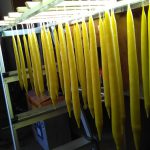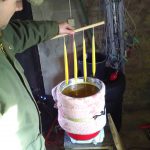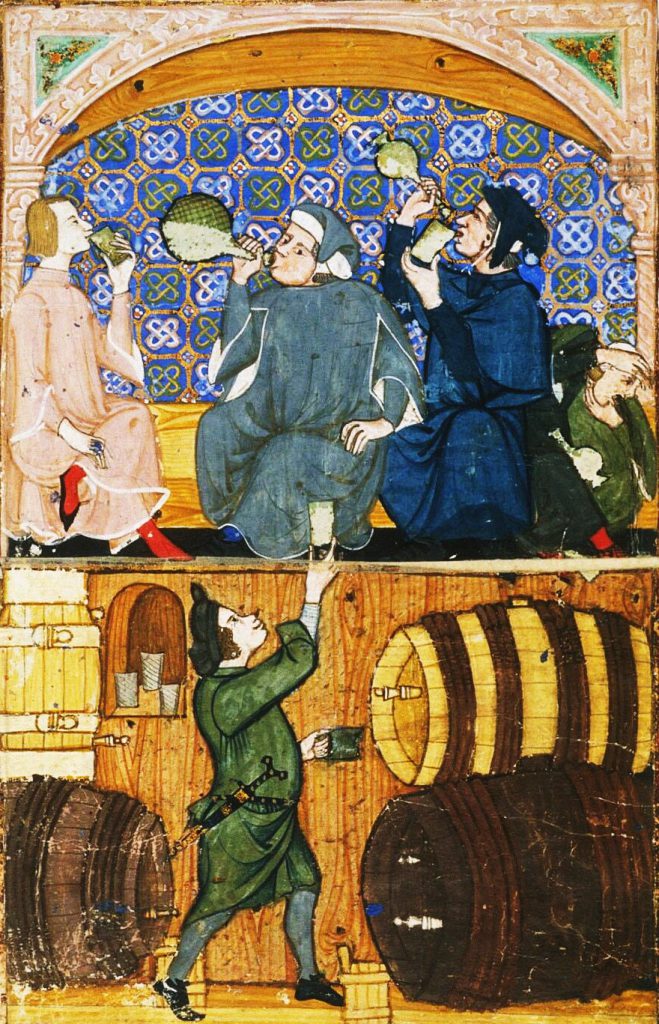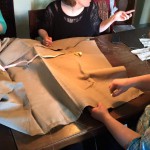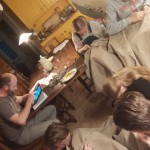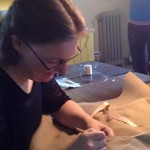Den värnpliktige
De inkallade mindre bemedlade borgarna drog generellt sett personligen i fält, vilket inte var lika vanligt när det gällde de rikare familjerna, som gärna skickade någon annan i sitt ställe (upp till 3 wepener – fotsoldater, schutzen – båg- eller armborstskyttar, eller buxenschutzen/büssenschütte – bösskyttar).
Träning
1347 finns belägg för att en skjutbana för båg- och armborstskytte fanns upprättad, vilket betyder att borgerskapet förväntades utveckla sina färdigheter. Ett sätt var att anordna skjuttävlingar, som till exempel papegojskjutning, som finns belagd från 1363. Vinnaren fick 6 scot.
Skjutbanan sköttes av fyra rådmän, fyra borgare och två åldermän och den skulle vara öppen från påsk till 8 september. Den underhölls löpande enligt de räkenskaper som finns bevarade1.
Qwartir
Staden delades från 1414 upp i fem Qwartir (det femte kvarteret avvecklades tidigt under 1420-talet) där de boende organiserades i vård och vaka, alltså brandskydd och vakt. I Elbing hade varje Qwartir ansvar för det stadsmursavsnitt och de torn som låg i anslutning till qwartiret. De boende, i form av områdets olika gillen och skrån, skötte både vakthållning och underhåll av ”sin” stadsmur. Det första Qwartiret hade till exempel guldsmederna och slaktarna ansvar för. Qwartiret hade också i uppgift att mönstra borgarnas militära utrustning2.
Rate
I Danzig bildade tio hushåll en Rate och med tanke på städernas täta kontakt är det inte orimligt att så var fallet också i Elbing.
Maye/Maije
Medan stadens försvar organiserades i ett antal Qwartir organiserades krigståget i så kallade Maye, vars storlek beror på hela styrkans storlek. Det rör sig om allt från 14 till 110 man, med ett snitt på 32 pers/Maye. Om man tar bort de båda extremerna 106 och 110 blir snittet 26 pers/Maye. Sannolikt är indelning gjord mer på sociala eller ståndsmässiga grunder än på taktiska. Cheferna och det finare folket hör alltid till den första mayen – Maye dominorum eller Herren Maye (hit hör också kockar, stadstjänstemän och musikanter, samt ofta vagnar av olika slag), medan de andra helt enkelt kallas dy andir/dritte Maye. Ett mellanting benämns som dy andir maye et dominorum – en blandning av vanligt folk och lite finare folk. Ordet maye sägs enligt en krönikör från 1377 betyda tält (maja) på de baltiska språken, vilket antyder att Maye står för tältlag.
Som mest bestod Elbings uppbåd av 550 man. I två andra fall var antalet 216 respektive 134. Bortsett från det var antalet aldrig över 100 och bara sällan över 50. Så få som 24 kom från Elbing på mönstring 1386.
Glevenyen/Spiess
En Maye bestod i sin tur av ett antal Glevenyen/Spiess – en stridsgrupp bestående av 2-5 lättare rustade väpnare och tyngre rustade herrar (ofta mer välbeställda borgare).
Milis eller legosoldater?
Innan 1410 hyr Elbing inte in yrkessoldater men i samband med Tannenberg finns belägg för att de gör det, liksom 1414. Det blir sedan allt vanligare med legosoldater.
Befälsordning
Qwartir
Qwartirmeister/Qwartirherre
Varje Qwartir leddes av två Qwartirherren, båda rådsmedlemmar, där en var ansvarig för försvar och en för brandsäkerhet. Under 1420-talet utökades antalet Qwartirherren till sex per Qwartir.
Ratemeister
Ratemeistern var chef för tio hushåll och var underställd Qwartirmeistern.
Maye
Houbtman/Mayeherrn
Chefen för varje Maye kallades Houbtman eller Mayehern (andra benämningar är capitaneis eller dominus). I flera fall fanns flera chefer i varje Maye och när de omnämns tillsammans kallas de Houbtlude. En Mayeherre kunde vara medlem av rådet eller vara en vanlig borgare. Han var chef tack vare sin ställning – inte tack vare sin förmåga att leda trupp.
Spiessführer/Glevenyer
Begreppet Glevenyer/Spiessführer kan syfta på en spjutbeväpnad ryttare, men sannolikt var Glevenyern chef för en Glevenye enligt ovan. Han var generellt sett tyngre rustad och kunde omge sig med sitt eget husfolk.
Wepener/Schutze
En Glevenye bestod av 2-5 Wepener – fotsoldater. I Mayen fanns också Schutzen (armborst- eller bågskyttar) och/eller Büssenschütten/Buxenschützen. I princip var samtliga soldater alltid beridna, men de slogs sannolikt inte till häst; de fungerade som beridet infanteri.
Yrken eller funktioner
Bortsett från de rent militära funktionerna finns också en form av tross, som liksom ”stabsfunktioner” som musikanter, fanbärare och chefer är knuten till Herren Maye.
Stab
- Houbtman/Maye herrn. Tillhör fälttågets ledning. Det var inte tvungen att varje Maye hade en houbtman/Maye herrn
- Stadsmusikant (pfyffer/piper) i form av flöjt- och/eller skalmejaspelare (2-3 stycken). Trummor finns belagda först under 1500-talet.
- Weddeherre/Stadstjänare – Weddeherren fungerade som ordningsman och hade tillsammans med kocken speciellt ansvar för bagaget.
- Kock – Kocken får rida på en av stadens hästar.
Tross
- Schäffer – En rådman som fungerade som dagens kvartermästare och ansvarar för bland annat proviantering.
- Beker
- Bader
- Artze
- Huffsmyt
- Maurer
- Zimmermann
- Knecht
- Wagenförer
- Werkmestere
- Swertsliper
Specialister
- Vorryder – Förridare – en slags spanare.
- Bussenschutte
- Armborstirer
- Armborstmakare
- Fanbärare (på stadens särskilda banérhingst ). Under 1500-talet finns belägg för att varje Qwartir i staden hade sin egen fana.
Sjöresor
I flera fall innebär krigstågen sjöresor, bland annat på fredsskepp. I de fallen hyr staden skepp och besättning från privatpersoner. Det rör sig om koggar och pråmar (antagligen på släp) där det i en del fall finns både kök och bakugn för resorna.
Löner
Hauptman (18 veckor för 30 mark – här en del av skeppsbesättning).
Kock ((18 veckor för 1 mark, 20 schot – skeppskock)
Bagare (18 veckor för 1 mark, 20 schot – skeppsbagare)
Armborstmakare (3 mark, 18 schot för 18 veckor)
Läkare (6 mark för att vårda en knekt)
Skeppare (4 M, 12 schot för 18 veckor)
Styrmän (2 M, 22 schot för 18 veckor)
Timmermän (2 M, 22 schot för 18 veckor)
Sjömän (3 M för 18 veckor)
Båtsmän (3 M för 18 veckor)
Skeppsgossar (18 schot för 18 veckor)
Åkare (6,5 M för 26 dagar)
Schützen – 7 schot i veckan (7 vierdung på sex veckor)/7 scot per vecka
Kock – 6 vierdung på sex veckor, 1,5 mark på sex veckor/6 scot per vecka (i de fall det är många som reser finns flera kockar med)
Utrustning och försörjning
Härens utrustning fraktades på vagnar eller slädar – ”wagen” eller ”harnaschwagen” – rustvagnar. I Herren Maye finns också ”Hern Wagen” – ”herrevagnar” – där huvudmän och rådsherrar som drog i fält åkte.
Stridsutrustning
Ibland kunde ett flertal borgare utrusta en Wepener tillsammans, genom att betala för häst och rustning. De olika yrkesgrupperna fick bidra beroende på storlek, verksamhetens natur och ekonomisk förmåga – ju rikare och ju fler skråmedlemmar desto fler soldater fick de ställa upp med. Den som inte skötte värnplikten fick böta.
Man kan alltså säga att var och en hade eget ansvar för sin utrustning, men gillet eller skrået hade också ett ansvar.
Under 1400-talets två första årtionden köper dessutom staden in omfattande mängder krigsmateriel – även rustningar och vapen, något som också är fallet i flera andra exempel: den nederländska staden Deventer ger 11 gesäller sex Gulden (cirka 4 mark) per person för inköp av harnesk och en “Hoftman” får i sin tur 15 Gulden till samma syfte (Hanserecessen, Verhandlungen zu Utrecht, 5 jun, 1394).
Värdet av den utrustning och häst som borgare drog I fält med, antecknades i Elbinger Kriegsbuch3. Det är möjligt att staden ersatte utrustning vid förlust.
Jämförelser
I grund och botten skulle en soldat från Elbing komma med ”häst och vapen” – allra minst:
- Plata/ringbrynja
- Kittelhatt
- Järnhandskar
Det stämmer i princip överens med minimikraven i Göttingen, 1397, där man ska ha
- Plata/panzar
- Stridshandskar
- Stångvapen
- Yxa
Det är intressant att lägga märke till att Elbings miniminivå inte innehåller något vapen, medan Göttingens miniminivå inte innehåller hjälm. Det är inte svårt att göra antagandet att respektive stad kompletterat utrustningen.
Utrustningsspecifikationen för en Wepener i Stockholmsuppdraget ser å sin sida ut så här:
- En hel platen harnasch och vad som hör därtill, alltså:
- Hube (ringbrynjehuva?)
- Bröst
- Armläder/Vorleder – överarmsskydd i läder
- Förstål/Vorstal – underarmsskydd i plåt
- Benvapen
- Sköld
Den specifikationen överensstämmer i sin tur ganska väl med Göttingens maxnivå, för de borgare som tjänar 20 Mark eller mer om året. De ska ha
- Ringbrynja
- Bascinet/hjärnhatt
- Armskydd i läder
- Plåthandskar
- ”Annat som hör därtill”
- Lans/stångvapen
Här kan man jämföra rådsherren Eberhard Russenbergs utrustning i Lübeck (1359)
- Bröst
- Ringbrynja
- ”Kjol” – som skyddar skrevet
- Krage
- Panzar/Vapenrock
- Aventail/brynjehuva/hjälmfoder
- 2 par handskar
- Underarms- och överarmsskenor i läder
Min tolkning är alltså att den utrustning som krävs av väpnade i Stockholmsexpeditionen motsvarar den hos borgerskapets översta skikt i Östersjöstäderna.
Försörjning och övrig utrustning
Staden stod för stora delar av övriga kostnader för den militära verksamheten; förbrukningsmaterial såsom bågsträngar, hästskor, foder, förplägnad, köksutrustning, kol, ved och så vidare, betalades av staden – liksom vagnar, hyra av fartyg och skeppsfolk. Krigståget behövde ofta föra med sig den utrustning och de livsmedel som var nödvändiga för krigståget; till och med i Stockholm där soldaterna låg i garnison var detta en utmaning. En stor del av dokumentationen från Stockholmsuppdraget är rena rekvisitionsbrev till de tyska Östersjöstäderna där Stockholms befälhavare ber om allt från spadar och vakthundar till mjöl och vin. I Elbinger Kriegsbuch nämns följande livsmedel och utrustning.
Livsmedel
- Mjöl
- Bröd
- Öl
- Mjöd
- Kött
- Späck/fläsk
- Fisk
- Ål
- Ärtor
- Kryddor
- Ost
- Saltat kött
- Smör
- Gryn
I andra källor från regionen nämns ytterligare matvaror, så det står klart att maten inte var alltför enahanda.
Övrig utrustning
- Ved
- Kol
- Husgeråd
- Bestick och tallrikar
- Hästskor
- Strängar till armborst
- Spadar
- Yxor
- Tyg till handdukar, dukar och säckar
- Stora mängder foder till djuren – en källa från 1372 nämner att hästarna till en trupp på 15 man (rimligtvis runt 30 stycken hästar) äter mer än 12 000 liter havre på två veckor.
Det är lite anmärkningsvärt att man också på krigståg tänker på handdukar och bordsdukar.
Rustkammare och vapeninköp
Elbing spenderade mycket pengar på krigsutrustning så som pilar (till bågar och armborst), pilbågar, olika former av armborst, spännanordningar till armborst, sköldar (stormsköldar och vanliga), krut, krutsilar, krutskopor, salpeter, svavel, kanonlavetter, bösstenar (små och stora), bössor (små och stora), sköldar, hjälmar, “halva” rustningar (från Rhenområdet, “hela” rustningar (från England), rhenska bröstplåtar, ringbrynjor, kittelhattar och andra hjälmar, talg (som rostskydd).
I Elbings rådhus finns år 1413 följande inventarier (tillhörande borgmästaren):
- 4 tunnor salpeter
- 4,5 tunnor krut, plus en säck krut
- 4 tunnor svavel
- 2 tunnor armborstpilar
- 21 kopparstenbössor
- 24 lodbössor
- Tre stora bössor
- 800 små stenkulor
- 44 mellanstora stenkulor
- 224 stora stenkulor
- Kanonutrustning (“hakar” för att avfyra bössorna, luntor (eventuellt), “järnproppar”?, järntänger för att hantera stenprojektiler, laddstake, zuker)
- Ett antal lavetter
- 72 stormsköldar
- 14 koger som kan fästas på sköldarna
- 3 spännanordningar för armborst
- Fem tunga armborst med spännanordningar
- 171 lättare armborst
- 2 bascineter + 2 med visir
- 2 kittelhattar
- 2 helrustningar
- 3 ringbrynjor
- 2 stridsyxor
- 23 520 armborstpilar (i lind)
Från 1410-1414 köper Elbing i övrigt in
- 2 stora kanoner (runt 300 kilo styck) och 3 lodbössor 1410
- 1 stor kanon och 14 lodbössor 1411
- 1 kanon (625 kilo), 7 kanoner, 10 stora och 13 små lodbössor 1414






